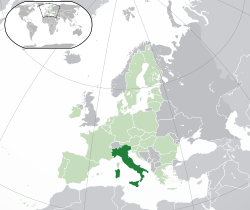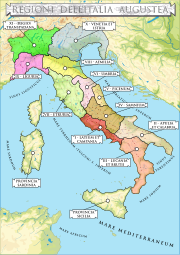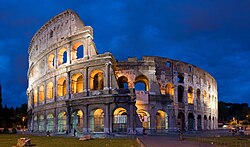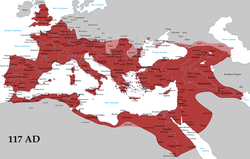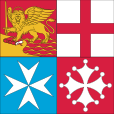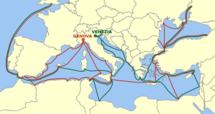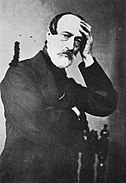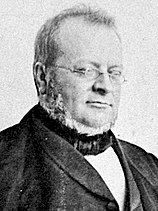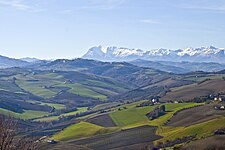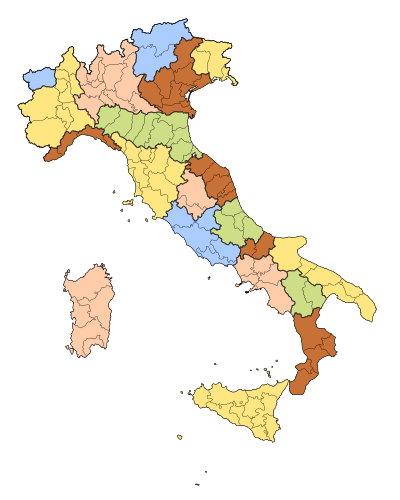
A | B | C | D | E | F | G | H | CH | I | J | K | L | M | N | O | P | Q | R | S | T | U | V | W | X | Y | Z | 0 | 1 | 2 | 3 | 4 | 5 | 6 | 7 | 8 | 9
This article may be too long to read and navigate comfortably. When this tag was added, its readable prose size was 21,000 words. (June 2023) |
Italian Republic Repubblica Italiana (Italian) | |
|---|---|
| Anthem: "Il Canto degli Italiani" "The Song of the Italians" | |
Location of Italy (dark green) – in Europe (light green & dark grey) | |
| Capital and largest city | Rome 41°54′N 12°29′E / 41.900°N 12.483°E |
| Official languages | Italiana |
| Nationality (2021)[1] |
|
| Native languages | See main article |
| Religion (2020)[2] |
|
| Demonym(s) | Italian |
| Government | Unitary parliamentary republic |
| Sergio Mattarella | |
| Giorgia Meloni | |
| Ignazio La Russa | |
| Lorenzo Fontana | |
| Legislature | Parliament |
| Senate of the Republic | |
| Chamber of Deputies | |
| Formation | |
| 17 March 1861 | |
• Republic | 12 June 1946 |
| 1 January 1948 | |
| 1 January 1958 | |
| Area | |
• Total | 301,340[3][4] km2 (116,350 sq mi) (71st) |
• Water (%) | 1.24 (2015)[5] |
| Population | |
• 2022 estimate | |
• Density | 201.3/km2 (521.4/sq mi) (71st) |
| GDP (PPP) | 2024 estimate |
• Total | |
• Per capita | |
| GDP (nominal) | 2024 estimate |
• Total | |
• Per capita | |
| Gini (2020) | medium |
| HDI (2022) | very high (30th) |
| Currency | Euro (€)b (EUR) |
| Time zone | UTC+1 (CET) |
• Summer (DST) | UTC+2 (CEST) |
| Date format | |
| Driving side | right |
| Calling code | +39c |
| ISO 3166 code | IT |
| Internet TLD | .itd |
| |
Italy,[a] officially the Italian Republic,[b] is a country in Southern[14] and Western[15][c] Europe. It is located on a peninsula that extends into the middle of the Mediterranean Sea, with the Alps on its northern land border, as well as several islands, notably Sicily and Sardinia.[16] Italy shares its borders with France, Switzerland, Austria, Slovenia and two enclaves: Vatican City and San Marino. Its territory also includes Campione (an exclave surrounded by Switzerland) and the Pelagie Islands (an archipelago in the African Plate). It is the tenth-largest country by land area in the European continent, covering an area of 301,340 km2 (116,350 sq mi),[3] and the third-most populous member state of the European Union, with a population of nearly 60 million.[17] Its capital and largest city is Rome.
In antiquity, the Italian peninsula was home to numerous peoples; the Latin city of Rome in central Italy, founded as a Kingdom, became a Republic that conquered the Mediterranean world and ruled it for centuries as an Empire.[18][19][20] With the spread of Christianity, Rome became the seat of the Catholic Church and of the Papacy. During the Early Middle Ages, Italy experienced the fall of the Western Roman Empire and inward migration from Germanic tribes. By the 11th century, Italian city-states and maritime republics expanded, bringing renewed prosperity through commerce and laying the groundwork for modern capitalism.[21][22] The Italian Renaissance flourished in Florence during the 15th and 16th centuries and spread to the rest of Europe. Italian explorers also discovered new routes to the Far East and the New World, leading the European Age of Discovery. However, centuries of rivalry and infighting between the Italian city-states among other factors left the peninsula divided into numerous states until the late modern period.[23][24] During the 17th and 18th centuries, Italian economic and commercial importance waned significantly.[25]
After centuries of political and territorial divisions, Italy was almost entirely unified in 1861, following wars of independence and the Expedition of the Thousand, establishing the Kingdom of Italy.[26] From the late 19th to the early 20th century, Italy rapidly industrialized, mainly in the north, and acquired a colonial empire,[27] while the south remained largely impoverished and excluded from industrialization, fueling a large immigrant diaspora to the Americas.[28] From 1915 to 1918, Italy took part in World War I on the side of the Entente against the Central Powers. In 1922, following a period of crisis and turmoil, the Italian fascist dictatorship was established. During World War II, Italy was first part of the Axis until its surrender to the Allied powers (1940–1943) and then, as parts of its territory were occupied by Nazi Germany with fascist collaboration, a co-belligerent of the Allies during the Italian resistance and the liberation of Italy (1943–1945). Following the end of the war, the monarchy was replaced by a republic, via a referendum; and the country enjoyed a strong recovery, which resulted in prolonged prosperity that is often termed "the economic miracle".[29]
Italy has the eighth-largest nominal GDP in the world, the second-largest manufacturing industry in Europe (7th-largest in the world),[30] and a significant role in regional[31][32] and global[33][34] economic, military, cultural, and diplomatic affairs. A developed country, ranking 30th in the Human Development Index, Italy is a founding and leading member of the European Union, and it is in numerous international institutions, including NATO, the G7, the Mediterranean Union, and the Latin Union. As a cultural superpower, Italy has long been a renowned centre of art, music, literature, cuisine, fashion, science and technology, and the source of multiple inventions and discoveries.[35] It has the world's largest number of World Heritage Sites (59), and is the world's fifth-most visited country.
Name
Hypotheses for the etymology of the name Italia are numerous.[36] One theory suggests that it originated from an Ancient Greek term that refers to the land of the Italói, a tribe that resided in the region now known as Calabria, located at the southern tip of the Italian peninsula. Originally thought to be named Vituli, some scholars suggest their totemic animal to be the calf (Lat vitulus, Umbrian vitlo, Oscan Víteliú).[37] Several ancient authors (Dionysius of Halicarnassus, Antiochus of Syracuse, Aristotle) have instead given the account that Italy to have been named after a local ruler named Italus.[38][39][40]
According to Antiochus of Syracuse, the ancient Greek term for Italy initially referred only to the southern portion of the Bruttium peninsula (corresponding to the modern province of Reggio) and parts of the provinces of Catanzaro and Vibo Valentia in southern Italy. Nevertheless, by his time the larger concept of Oenotria and "Italy" had become synonymous, and the name also applied to most of Lucania as well. According to Strabo's Geographica, before the expansion of the Roman Republic, the name was used by ancient Greeks to indicate the land between the strait of Messina and the line connecting the gulf of Salerno and gulf of Taranto, corresponding roughly to the current region of Calabria. The ancient Greeks gradually came to apply the name "Italia" to a larger region.[41] In addition to the "Greek Italy" in the south, historians have suggested the existence of an "Etruscan Italy", which consisted of areas of central Italy.[42]
The borders of Roman Italy, Italia, are better established. Cato's Origines, the first work of history composed in Latin, describes Italy as the entire peninsula south of the Alps.[43] According to Cato and several Roman authors, the Alps formed the "walls of Italy".[44] In 264 BC, Roman Italy extended from the Arno and Rubicon rivers of the centre-north to the entire south. The northern area, Cisalpine Gaul, which was considered geographically and de facto part of Italy, was occupied by Rome in the 220s BC,[45] but remained politically and de jure separated. It was legally merged into the administrative unit of Italy in 42 BC by the triumvir Octavian, as planned by Julius Caesar.[46][47][48][49][50] The islands of Sardinia, Corsica, Sicily, and Malta were added to Italy by Diocletian in 292 AD,[51] which made late-ancient Italy coterminous with the modern Italian geographical region.[52] All its inhabitants were considered Italic and Roman.[53]
The Latin term Italicus was used to describe "a man of Italy" as opposed to a provincial, or one from the Roman province. For example, Pliny the Elder notably wrote in a letter Italicus es an provincialis? ("are you an Italian or a provincial"?).[54] The adjective italianus, from which the term Italian was derived (as well as in French), is from medieval Latin and was used alternatively with Italicus during the early modern period.[55]
After the fall of the Western Roman Empire, the Ostrogothic Kingdom of Italy was created. After the Lombard invasions, Italia was retained as the name for their kingdom, and for its successor kingdom within the Holy Roman Empire, which nominally lasted until 1806, although its power in Italy declined due to factional politics pitting the empire against the ascendance of city republics in the 13th century.[56]
History
Prehistory and antiquity

Thousands of Lower Paleolithic artefacts, dating as far back as 850,000 years, have been recovered from Monte Poggiolo.[57] Excavations throughout Italy revealed a Neanderthal presence dating back to the Middle Palaeolithic period some 200,000 years ago,[58] while modern humans appeared about 40,000 years ago at Riparo Mochi.[59][60]
The ancient peoples of pre-Roman Italy – such as the Umbrians, the Latins, Volsci, Oscans, Samnites, Sabines, the Celts, the Ligures, the Veneti, the Iapygians, and many others – were Indo-European peoples, most of them specifically of the Italic group. The main historic peoples of possible non-Indo-European or pre-Indo-European heritage include the Etruscans of central and northern Italy, the Elymians and the Sicani of Sicily, and the prehistoric Sardinians, who gave birth to the Nuragic civilisation. Other ancient populations of undetermined language families, of possibly non-Indo-European origins, include the Rhaetian people and Cammuni; known for their rock carvings in Valcamonica, which houses the largest collection of prehistoric petroglyphs in the world.[61] A well-preserved natural mummy known as Ötzi the Iceman, dated to between 3400 and 3100 BC, was discovered in the Similaun glacier of South Tyrol in 1991.[62]
The first foreign colonizers were the Phoenicians, who initially established colonies and founded various emporiums on the coasts of Sicily and Sardinia. Some of these became small urban canters and developed parallel to the ancient Greek colonies. Among the main centres there were the cities of Motya, Zyz, Soluntum in Sicily, and Nora, Sulci, and Tharros in Sardinia.[63]
Between the 17th and the 11th centuries BC, Mycenaean Greeks established contacts with Italy.[64][65][66] During the 8th and 7th centuries, a number of Greek colonies were established at Pithecusae, eventually extending along the south of the Italian Peninsula and the coast of Sicily, an area that was later known as Magna Graecia.[67]
Ionian settlers founded Elaia, Kyme, Rhegion, Naxos, Zankles, Hymera, and Katane. Doric colonists founded Taras, Syrakousai, Megara Hyblaia, Leontinoi, Akragas, and Ghelas; the Syracusans founded Ankón and Adria; the Megarese founded Selinunte. The Achaeans founded Sybaris, Poseidonia, Kroton, Lokroi Epizephyrioi, and Metapontum; tarantini and thuriots found Herakleia. The Greek colonization placed the Italic peoples in contact with democratic forms of government and with high artistic and cultural expressions.[68]
Ancient Rome
Ancient Rome, a settlement around a ford on the River Tiber in central Italy and founded in 753 BC, according to tradition, was ruled for a period of 244 years by a monarchical system, initially by sovereigns of Latin and Sabine origin, later by Etruscan kings. This tradition enumerated seven kings: Romulus, Numa Pompilius, Tullus Hostilius, Ancus Marcius, Tarquinius Priscus, Servius Tullius, and Tarquinius Superbus. In 509 BC, the Romans, favouring a government of the Senate and the People (SPQR), expelled the monarchy from their city and established an oligarchic republic.
The Italian Peninsula, named Italia, was consolidated into a unified entity during the Roman expansion, the conquest of new territories being often at the expense of the other Italic tribes, Etruscans, Celts, and Greeks. A permanent association, with most of the local tribes and cities, was formed, and Rome began the conquest of Western Europe, Northern Africa, and the Middle East. In the wake of Julius Caesar's rise and assassination in the 1st century BC, Rome over the course of centuries grew into a massive empire stretching from Britain to the borders of Persia, engulfing the whole Mediterranean basin, in which Greek, Roman, and many other cultures merged into a unique civilisation. The long and triumphant reign of the first emperor, Augustus, began a golden age of peace and prosperity. Roman Italy remained the metropole of the empire, the homeland of the Romans and the territory of the capital.[69][70][71]
The Roman Empire was among the largest empires in world history, and it wielded great economical, cultural, political, and military power. At its greatest extent, under Emperor Trajan, it had an area of 5 million square kilometres (1.9×106 sq mi).[72][73] The Roman legacy has deeply influenced Western civilisation shaping most of the modern world; such as the widespread use of the Romance languages derived from Latin, the numerical system, the modern Western alphabet and calendar, and the emergence of Christianity as a major world religion are among the many legacies of Roman dominance.[74]
Middle Ages

After the fall of the Western Roman Empire, Italy fell under the power of Odoacer's kingdom, and later was seized by the Ostrogoths,[75] which was followed by a brief reconquest under Byzantine Emperor Justinian in the 6th century. Invasions of the peninsula resulted in a chaotic succession of barbarian kingdoms and the supposed "dark ages". The invasion of another Germanic tribe, the Lombards, late in the same century, reduced the Byzantine presence to the rump realm of the Exarchate of Ravenna and ended political unity of the peninsula for the next 1,300 years. The peninsula was therefore divided into northern Italy and Tuscany forming the Lombard kingdom, with its capital in Pavia, and central-southern Italy, including the duchies of Spoleto and Benevento, controlled by the Lombards. The remaining part of the peninsula remained under the Byzantines and was divided between the exarchate of Italy, based in Ravenna, the Duchy of Rome, the Duchy of Naples, the Duchy of Calabria, and Sicily, the latter being directly dependent on the emperor at Constantinople.[76]
The Lombard kingdom was subsequently absorbed into the Frankish Empire by Charlemagne in the late 8th century and became the Kingdom of Italy.[77] The Franks helped the formation of the Papal States in central Italy. Until the 13th century, Italian politics was dominated by the relations between the Holy Roman Emperors and the Papacy, with most of the Italian city-states siding with the former (Ghibellines) or with the latter (Guelphs) for momentary advantage.[78]
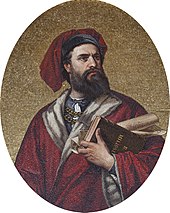
The Germanic emperor and the Roman pontiff became the universal powers of medieval Europe. However, the conflict over the Investiture Controversy and the clash between Guelphs and Ghibellines led to the end of the imperial-feudal system in the north of Italy, where city-states gained independence.[79] The investiture controversy was finally resolved by the Concordat of Worms. In 1176, a league of city-states, the Lombard League, defeated the German emperor Frederick Barbarossa at the Battle of Legnano, thus ensuring effective independence for most of northern and central Italian cities.
Italian city-states—such as Milan, Florence, and Venice—played a crucially innovative role in financial development by devising the main instruments and practices of banking and emerging new forms of social and economic organization.[80] In coastal and southern areas, the maritime republics eventually dominated the Mediterranean and monopolised trade routes to the Orient. They were independent thalassocratic city-states, though most of them originated from territories belonging to the Byzantine Empire. All these cities during the time of their independence had similar systems of government in which the merchant class had considerable power. Although in practice these were oligarchical, and bore little resemblance to a modern democracy, the relative political freedom they afforded was conducive to academic and artistic advancement.[81] The four best-known maritime republics were Venice, Genoa, Pisa, and Amalfi; the others were Ancona, Gaeta, Noli, and Ragusa.[82][83][84] Each of the maritime republics had dominion over different overseas lands, including many Mediterranean islands, lands on the Adriatic, Aegean, and Black seas, and commercial colonies in the Near East and in North Africa. Venice maintained enormous tracts of land in Greece, Cyprus, Istria, and Dalmatia until the mid-17th century.[85]
Right: trade routes and colonies of the Genoese (red) and Venetian (green) empires
Venice and Genoa were Europe's main gateways to trade with the East, and producers of fine glass, while Florence was a centre of silk, wool, banking, and jewellery. The wealth and business brought to Italy meant that large public and private artistic projects could be commissioned. The republics were heavily involved in the Crusades, providing support and transport, but mostly taking advantage of the political and trading opportunities resulting from the wars.[81] Italy first felt the huge economic changes in Europe which led to the commercial revolution: the Republic of Venice was able to defeat the Byzantine Empire and finance the voyages of Marco Polo to Asia; the first universities were formed in Italian cities, and scholars such as Thomas Aquinas obtained international fame; Frederick I of Sicily made Italy the political-cultural centre of a reign that temporarily included the Holy Roman Empire and the Kingdom of Jerusalem; capitalism and banking families emerged in Florence, where Dante and Giotto were active around 1300.[21]
In the south, Sicily had become an Arab Islamic emirate in the 9th century, thriving until the Italo-Normans conquered it in the late 11th century, together with most of the Lombard and Byzantine principalities of southern Italy.[86] Through a complex series of events, southern Italy developed as a unified kingdom, first under the House of Hohenstaufen, then the Capetian House of Anjou, and under the House of Aragon from the 15th century. In Sardinia, the former Byzantine provinces became independent states known in Italian as Judicates, although some parts of the island fell under Genoese or Pisan rule until Aragonese annexation in the 15th century. The Black Death of 1348 left its mark on Italy by killing perhaps one third of the population.[87][88]
Early modern period

Italy was the birthplace and heart of the Renaissance during the 1400s and 1500s. The Italian Renaissance marked the transition from the medieval period to the modern age as Europe recovered, economically and culturally, from the crises of the Late Middle Ages and entered the Early Modern Period. The Italian polities were now regional states effectively ruled by princes, who were de facto monarchs in control of trade and administration, and their courts became major centres of the arts and sciences. The Italian princedoms represented the first modern states, as opposed to feudal monarchies and multinational empires. The princedoms were led by political dynasties and merchant families such as the Medici in Florence; the Visconti and Sforza in the Duchy of Milan; the Doria in the Republic of Genoa; the Loredan, Mocenigo, and Barbarigo in the Republic of Venice; the Este in Ferrara; and the Gonzaga in Mantua.[89][90] The Renaissance was fostered by the wealth accumulated by Italian merchant cities combined and the patronage of its dominant families.[89] Italian Renaissance exercised a dominant influence on subsequent European painting and sculpture for centuries afterwards, with artists such as Leonardo da Vinci, Brunelleschi, Botticelli, Michelangelo, Raphael, Giotto, Donatello, and Titian, and architects such as Filippo Brunelleschi, Leon Battista Alberti, Andrea Palladio, and Donato Bramante.
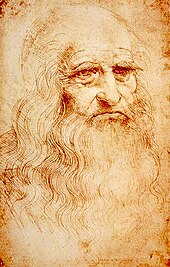
Following the conclusion of the western schism in favour of Rome at the Council of Constance (1415–1417), newly elected Pope Martin V returned to the Papal States after a three-year-long journey that touched many Italian cities and restored Italy as the sole centre of Western Christianity. During the course of this voyage, the Medici Bank was made the official credit institution of the Papacy, and several significant ties were established between the Church and the new political dynasties of the peninsula. The Popes' status as elective monarchs turned the conclaves and consistories of the Renaissance into political battles between the courts of Italy for primacy in the peninsula and access to the immense resources of the Catholic Church. In 1439, Pope Eugenius IV and the Byzantine Emperor John VIII Palaiologos signed a reconciliation agreement between the Catholic Church and the Orthodox Church at the Council of Florence hosted by Cosimo the old de Medici. In 1453, Italian forces under Giovanni Giustiniani were sent by Pope Nicholas V to defend the Walls of Constantinople but the decisive battle was lost to the more advanced Turkish army, which was equipped with cannons, and Byzantium fell to Sultan Mehmed II.
The fall of Constantinople led to the migration of Greek scholars and texts to Italy, fuelling the rediscovery of Greco-Roman Humanism.[91][92][93] Humanist rulers such as Federico da Montefeltro and Pope Pius II worked to establish ideal cities where man is the measure of all things, and therefore founded Urbino and Pienza, respectively. Pico della Mirandola wrote the Oration on the Dignity of Man, considered as the manifesto of Renaissance Humanism, in which he stressed the importance of free will in human beings. The humanist historian Leonardo Bruni was the first to divide human history into three periods: Antiquity, Middle Ages, and Modernity.[94] The second consequence of the Fall of Constantinople was the beginning of the Age of Discovery.
Italian[d] explorers and navigators from the dominant maritime republics, eager to find an alternative route to the Indies in order to bypass the Ottoman Empire, offered their services to monarchs of Atlantic countries and played a key role in ushering the Age of Discovery and the European colonization of the Americas. The most notable among them were: Christopher Columbus, colonizer in the name of Spain, who is credited with discovering the New World and the opening of the Americas for conquest and settlement by Europeans;[95] John Cabot, sailing for England, who was the first European to set foot in "New Found Land" and explore parts of the North American continent in 1497;[96] Amerigo Vespucci, sailing for Portugal, who, around 1501, first demonstrated that the New World was not Asia as initially conjectured, but a fourth continent previously unknown to people of the Old World;[97] and Giovanni da Verrazzano, in the service of France, is renowned as the first European to explore the Atlantic coast of North America between Florida and New Brunswick in 1524.[98]
Following the fall of Constantinople, the wars in Lombardy came to an end; and a defensive alliance known as Italic League was formed between Venice, Naples, Florence, Milan, and the Papacy. Lorenzo the Magnificent de Medici was the greatest Florentine patron of the Renaissance and supporter of the Italic League. His support notably allowed the League to maintain itself in the aftermath of the Pazzi Conspiracy and aborted the invasion of Italy by the Turks. However, the military campaign of Charles VIII of France in Italy resulted in the disbandment of the League and initiated the Italian Wars between the Valois and the Habsburgs. During the High Renaissance of the 1500s, Italy was, therefore, the main European battleground as well as the cultural-economic centre of the continent. Popes such as Julius II (1503–1513) fought for the control of Italy against foreign monarchs; others, such as Paul III (1534–1549), preferred to mediate between the European powers in order to secure peace in Italy. In the middle of this conflict, the Medici popes Leo X (1513–1521) and Clement VII (1523–1534) opposed the Protestant Reformation and advanced the interests of their family. In 1559, at the end of the French invasions of Italy and of the Italian wars, many states of northern Italy remained as part of the Holy Roman Empire, indirectly subjected to the Austrian Habsburgs, while all of Southern Italy (Naples, Sicily, Sardinia) and Milan were under the Spanish Habsburg rule.
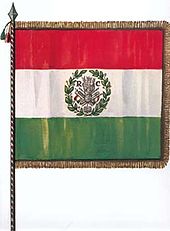
The Papacy remained a powerful force and launched the Counter-reformation. Key events of the period include: the Council of Trent (1545–1563); the excommunication of Elizabeth I (1570) and the Battle of Lepanto (1571), which occurred during the pontificate of Pius V; the construction of the Gregorian observatory, the adoption of the Gregorian calendar, and the Jesuit China mission of Matteo Ricci under Pope Gregory XIII; the French Wars of Religion; the Long Turkish War and the execution of Giordano Bruno in 1600, under Pope Clement VIII; the birth of the Lyncean Academy of the Papal States, of which the main figure was Galileo Galilei (later put on trial); the final phases of the Thirty Years' War (1618–1648) during the pontificates of Urban VIII and Innocent X; and the formation of the last Holy League by Innocent XI during the Great Turkish War.
The Italian economy declined during the 1600s and 1700s. Following the European wars of succession of the 18th century, the North fell under the influence of the Habsburg-Lorraine of Austria, while the South was passed to a cadet branch of the Spanish Bourbons. During the Coalition Wars, northern and central Italy were reorganised by Napoleon as a number of Sister Republics of France and, later, as a Kingdom of Italy in personal union with the French Empire.[99] The southern half of the peninsula was administered by Joachim Murat, Napoleon's brother-in-law, who was crowned as King of Naples. The 1814 Congress of Vienna restored the situation of the late 18th century, but the ideals of the French Revolution could not be eradicated, and soon re-surfaced during the political upheavals that characterised the first part of the 19th century.
The Italian national colours appeared initially on a tricolour cockade in 1789,[100] seven years before the adoption of the first green, white, and red Italian war flag[clarification needed] by the Lombard Legion in 1796.[101] The first official adoption of the Italian tricolour as a national flag by a sovereign Italian state, the Cispadane Republic, took place in 1797, during the Napoleonic era, following the French Revolution (1789–1799), which advocated national self-determination.[102][103] This event is celebrated by Tricolour Day.[104]
Unification
The birth of the Kingdom of Italy was the result of efforts of Italian nationalists and monarchists loyal to the House of Savoy to establish a united kingdom encompassing the entire Italian Peninsula. By the mid-19th century, rising Italian nationalism—along with other social, economic, and military events—led to a period of revolutionary political upheaval.[107] Following the Congress of Vienna in 1815, the political and social Italian unification movement, or Risorgimento, emerged to unite Italy by consolidating the different states of the peninsula and liberating them from foreign control. A prominent radical figure was the patriotic journalist Giuseppe Mazzini, a member of the secret revolutionary society, the Carbonari, and founder of the influential political movement Young Italy in the early 1830s, who favoured a unitary republic and advocated a broad nationalist movement. His prolific output of propaganda helped the unification movement stay active.
In this context, in 1847 the first public performance of the song "Il Canto degli Italiani", which became the Italian national anthem in 1946, took place.[108][109] The anthem, written by Goffredo Mameli and set to music by Michele Novaro, is also known as the Inno di Mameli, after the author of the lyrics, or as the Fratelli d'Italia, from its opening line.
The most famous member of Young Italy was the revolutionary and general Giuseppe Garibaldi, who was renowned for his extremely loyal followers[110] and who led the Italian republican drive for unification in Southern Italy. However, the northern Italian monarchy of the House of Savoy, in the Kingdom of Sardinia, whose government was led by Camillo Benso, Count of Cavour, also had ambitions of establishing a united Italian state. In the context of the 1848 liberal revolutions that swept through Europe, an unsuccessful first war of independence was declared against Austria. In 1855, the Kingdom of Sardinia became an ally of Britain and France in the Crimean War, making Cavour's diplomacy legitimate in the eyes of the great powers.[111][112] The Kingdom of Sardinia fought the Austrian Empire in the Second Italian War of Independence of 1859, with the aid of France, resulting in liberating Lombardy. On the basis of the Plombières Agreement, the Kingdom of Sardinia ceded Savoy and Nice to France, an event that caused the Niçard exodus, which involved the emigration of a quarter of the Niçard Italians to Italy,[113] and the Niçard Vespers.
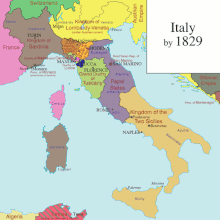
In 1860–1861, Garibaldi led the drive for unification in Naples and Sicily,[114] while the House of Savoy troops occupied the central territories of the Italian peninsula, except for Rome and part of the Papal States. Teano was the site of the famous meeting (on 26 October 1860) between Garibaldi and Victor Emmanuel II, the last king of Sardinia, during which Garibaldi shook Victor Emanuel's hand and hailed him as King of Italy. Thus, Garibaldi sacrificed republican hopes for the sake of Italian unity under a monarch. Cavour agreed to include Garibaldi's Southern Italy in a union with the Kingdom of Sardinia in 1860. This allowed the Sardinian government to declare a united Italian kingdom on 17 March 1861.[115] Victor Emmanuel II then became the first king of a united Italy, and its capital was moved from Turin to Florence. The title of "King of Italy" had been unused since the abdication of Napoleon I of France on 6 April 1814.
In 1866, Victor Emmanuel II, allied with Prussia during the Austro-Prussian War, waged the Third Italian War of Independence, which resulted in Italy annexing Venetia. Finally, in 1870, as France abandoned its garrisons in Rome during the disastrous Franco-Prussian War to keep the large Prussian Army at bay in France, the Italians filled the power gap by capturing the Papal States. Italian unification was completed, and shortly afterwards Italy's capital was moved to Rome. Victor Emmanuel, Garibaldi, Cavour, and Mazzini have been referred as Italy's Four Fathers of the Fatherland.[105]
Liberal period
The new Kingdom of Italy obtained Great Power status. The Constitutional Law of the Kingdom of Sardinia, the Albertine Statute of 1848, was extended to the whole Kingdom of Italy in 1861, and provided basic freedoms for the new state; but electoral laws excluded the non-propertied and uneducated classes from voting. The new kingdom was governed within a framework of parliamentary constitutional monarchy dominated by liberal forces. As northern Italy quickly industrialised, the southern and northern rural areas remained underdeveloped and overpopulated, forcing millions of people to migrate abroad and fuelling a large and influential diaspora. The Italian Socialist Party constantly increased in strength, challenging the traditional liberal and conservative establishment.
Starting in the last two decades of the 19th century, Italy developed into a colonial power by subjugating Eritrea and Somalia in East Africa, Tripolitania and Cyrenaica in North Africa, and the Dodecanese islands.[116] From 2 November 1899 to 7 September 1901, Italian troops were a contingent of the Eight-Nation Alliance forces during the Boxer Rebellion in China. On 7 September 1901, a concession in Tientsin was ceded to the country, and on 7 June 1902, the concession was taken into Italian possession and administered by a consul. In 1913, male universal suffrage was adopted. The pre–World War I period was dominated by Giovanni Giolitti, who was prime minister five times between 1892 and 1921, was characterised by the economic, industrial, and political-cultural modernization of Italian society.
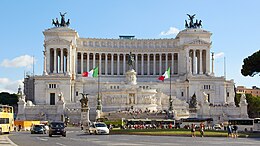
Italy entered into the First World War in 1915 with the aim of completing national unity: for this reason, the Italian intervention in the First World War is also considered the Fourth Italian War of Independence,[117] from a historiographical perspective that identifies the latter as the conclusion of the unification of Italy.[118][119]
Italy, nominally allied with the German Empire and the Empire of Austria-Hungary in the Triple Alliance, in 1915 joined the Allies, entering World War I with a promise of substantial territorial gains that included western Inner Carniola, the former Austrian Littoral, and Dalmatia, as well as parts of the Ottoman Empire. The country's contribution to the Allied victory earned it a place as one of the "Big Four" Allied powers. The war on the Italian Front was initially inconclusive, as the Italian army got stuck in a long war of attrition in the Alps, making little progress while suffering heavy losses. However, the reorganization of the army and instition of conscription led to Italian victories in major battles. Eventually, in October 1918, the Italians launched a massive offensive, culminating in victory in the Battle of Vittorio Veneto. That victory,[120][121][122] which was announced by the Bollettino della Vittoria and the Bollettino della Vittoria Navale, marked the end of the war on the Italian Front, secured the dissolution of the Austro-Hungarian Empire, and was instrumental in ending the First World War less than two weeks later. Italian armed forces were also involved in the African theatre, the Balkan theatre, the Middle Eastern theatre, and then took part in the Occupation of Constantinople.
During the war, more than 650,000 Italian soldiers and as many civilians died,[123] and the kingdom was on the brink of bankruptcy. The Treaty of Saint-Germain-en-Laye (1919) and the Treaty of Rapallo (1920) allowed for the annexation of Trentino Alto-Adige, the Julian March, Istria, and the Kvarner Gulf, as well as the Dalmatian city of Zara. The subsequent Treaty of Rome (1924) led to the annexation of the city of Fiume by Italy. Italy did not receive other territories promised by the Treaty of London, so this outcome was denounced as a "mutilated victory". The rhetoric of "mutilated victory" was adopted by Benito Mussolini, led to the rise of Italian fascism, and became a key point in the propaganda of Fascist Italy. Historians regard "mutilated victory" as a "political myth", used by fascists to fuel Italian imperialism and obscure the successes of liberal Italy in the aftermath of World War I.[124] Italy gained a permanent seat in the League of Nations's executive council.
Fascist regime
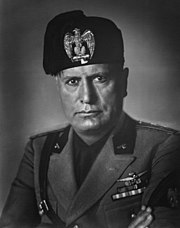
The socialist agitations that followed the devastation of the Great War, inspired by the Russian Revolution, led to counter-revolution and repression throughout Italy. The liberal establishment, fearing a Soviet-style revolution, started to endorse the small National Fascist Party, led by Benito Mussolini. In October 1922, the Blackshirts of the National Fascist Party organized a mass demonstration and a coup named the "March on Rome"; Prime Minister Luigi Facta wished to declare a state of siege, but this was overruled by King Victor Emmanuel III, who, on 30 October 1922, appointed Mussolini as prime minister, thereby transferring political power to the fascists without armed conflict.[125][126] Over the next few years, Mussolini banned all political parties and curtailed personal liberties, thus establishing a dictatorship. These actions attracted international attention and eventually inspired similar dictatorships such as those in Nazi Germany and Francoist Spain.
Italian Fascism is based upon Italian nationalism and imperialism, and, in particular, seeks to complete what it considers as the incomplete project of the unification of Italy by incorporating Italia Irredenta (unredeemed Italy) into the state of Italy.[127][128] To the east of Italy, the Fascists claimed that Dalmatia was a land of Italian culture, whose Italians, including those of Italianized South Slavic descent, had been driven out of Dalmatia and into exile in Italy, and supported the return of Italians of Dalmatian heritage.[129] Mussolini identified Dalmatia as having had strong Italian cultural roots for centuries, similarly to Istria, via the Roman Empire and the Republic of Venice.[130] To the south of Italy, the Fascists claimed Malta, which belonged to the United Kingdom, and Corfu, which belonged to Greece; to the north they claimed Italian Switzerland; while to the west they claimed Corsica, Nice, and Savoy, which belonged to France.[131][132] The Fascist regime produced literature on Corsica that presented evidence of the island's italianità.[133] The Fascist regime produced literature on Nice that justified that Nice was an Italian land, based on historic, ethnic, and linguistic grounds.[133]

The Armistice of Villa Giusti, which ended fighting between Italy and Austria-Hungary at the end of World War I, resulted in the Italian annexation of neighbouring parts of Yugoslavia. During the interwar period, the fascist Italian government undertook a campaign of Italianisation in the annexed areas, during which it suppressed Slavic language, schools, political parties, and cultural institutions. Between 1922 and the beginning of World War II, the affected people were also the German- and Ladin-speaking populations of Trentino-Alto Adige, and the French- and Arpitan-speaking regions of the western Alps, such as the Aosta valley.[134]
Mussolini promised to bring Italy back as a great power in Europe, building a "New Roman Empire"[135] and holding power over the Mediterranean Sea. In propaganda, Fascists used the ancient Roman motto Mare Nostrum to describe the Mediterranean. For this reason the Fascist regime engaged in interventionist foreign policy. In 1923, the Greek island of Corfu was briefly occupied by Italy, after the assassination of General Tellini in Greek territory. In 1925, Italy forced Albania to become a de facto protectorate. In 1935, Mussolini invaded Ethiopia and founded Italian East Africa, resulting in international isolation and leading to Italy's withdrawal from the League of Nations. Italy then allied with Nazi Germany and the Empire of Japan, and strongly supported Francisco Franco in the Spanish Civil War. In 1939, Italy formally annexed Albania. Italy entered World War II on 10 June 1940. The Italians initially advanced in British Somaliland, Egypt, the Balkans (establishing the Governorate of Dalmatia and Montenegro, the Province of Ljubljana, and the puppet states Independent State of Croatia and Hellenic State), and eastern fronts. They were, however, subsequently defeated on the Eastern Front as well as in the East African and North African campaigns, losing as a result their territories in Africa and in the Balkans.
During World War II, Italian war crimes included extrajudicial killings and ethnic cleansing[136] by deportation of about 25,000 people—mainly Jews, Croats, and Slovenians—to the Italian concentration camps, such as Rab, Gonars, Monigo, Renicci di Anghiari, and elsewhere. Yugoslav Partisans perpetrated their own crimes against the local ethnic Italian population during and after the war, including the foibe massacres. In Italy and Yugoslavia, unlike in Germany, few war crimes were prosecuted.[137][138][139][140]

An Allied invasion of Sicily began in July 1943, leading to the collapse of the Fascist regime and the fall of Mussolini on 25 July. Mussolini was deposed and arrested by order of King Victor Emmanuel III, in co-operation with the majority of the members of the Grand Council of Fascism, which passed a motion of no confidence. On 8 September, Italy signed the Armistice of Cassibile, ending its war with the Allies. Shortly thereafter, the Germans, with the assistance of the Italian fascists, succeeded in taking control of northern and central Italy. The country remained a battlefield for the rest of the war, with the Allies slowly moving up from the south.
In the north, the Germans set up the Italian Social Republic (RSI), a Nazi puppet state with Mussolini installed as leader after he was rescued by German paratroopers. Some Italian troops in the south were organised into the Italian Co-belligerent Army, which fought alongside the Allies for the rest of the war, while other Italian troops, loyal to Mussolini and his RSI, continued to fight alongside the Germans in the National Republican Army. Also, the post-armistice period saw the rise of a large anti-fascist resistance movement, the Resistenza.[141] As a result, the country descended into civil war;[142][143] the Italian resistance fought a guerrilla war against the Nazi German occupiers and Italian Fascist forces,[141] while clashes between the Fascist RSI Army and the Royalist Italian Co-Belligerent Army were rare.[144] In late April 1945, with total defeat looming, Mussolini attempted to escape north,[145] but was captured and summarily executed near Lake Como by Italian partisans. His body was then taken to Milan, where it was hung upside down at a service station for public viewing and to provide confirmation of his demise.[146]
Hostilities ended on 29 April 1945, when the German forces in Italy surrendered. Nearly half a million Italians died in the conflict,[147] society was divided, and the Italian economy had been all but destroyed—per capita income in 1944 was at its lowest point since the beginning of the 20th century.[148] The aftermath left Italy angry with the monarchy for its endorsement of the Fascist regime for the previous twenty years. These frustrations contributed to a revival of the Italian republican movement.[149]
Republican era
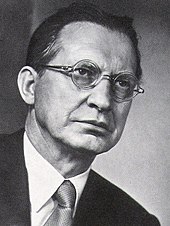
Italy became a republic after the 1946 Italian institutional referendum[150] held on 2 June, a day celebrated since as Festa della Repubblica. This was the first time Italian women voted at the national level.[151][152] Victor Emmanuel III's son, Umberto II, was forced to abdicate and go into exile. The Republican Constitution was approved in 1948. Under the Treaty of Peace with Italy, 1947, areas next to the Adriatic Sea were annexed by Yugoslavia, resulting in the Istrian-Dalmatian exodus, which involved the emigration of between 230,000 and 350,000 ethnic Italians, the others being ethnic Slovenians, ethnic Croatians, and ethnic Istro-Romanians, choosing to maintain Italian citizenship.[153] Later, the Free Territory of Trieste was divided between the two states. Italy lost all of its colonial possessions, formally ending the Italian Empire. The Italian border today has existed since 1975, when Trieste was formally re-annexed to Italy.
Fears of a possible Communist takeover proved crucial on 18 April 1948, when the Christian Democrats, under Alcide De Gasperi, won a landslide victory.[154][155] Consequently, in 1949 Italy became a member of NATO. The Marshall Plan revived the Italian economy, which, until the late 1960s, enjoyed a period of sustained economic growth commonly called the Economic Miracle. In the 1950s, Italy became one of the six founding countries of the European Communities, a forerunner of the European Union.
From the late 1960s until the early 80s, the country experienced the Years of Lead, a period characterised by economic crisis, especially after the 1973 oil crisis; widespread social conflicts; and terrorist massacres.[156][157][158]
In the 1980s, for the first time since 1945, two governments were led by non-Christian-Democrat premiers: one republican and one socialist; the Christian Democrats remained, however, the main government party. The economy recovered and Italy became the world's fifth-largest industrial nation after it gained entry into the G7 in the 1970s. However, the Italian national debt skyrocketed passing 100% of the country's GDP.
Between 1992 and 1993, Italy faced terror attacks perpetrated by the Sicilian Mafia as a consequence of new anti-mafia measures launched by the government.[159] A year later, tourist spots were attacked, leaving 10 dead and 93 injured and causing severe damage to cultural heritage sites such as the Uffizi Gallery. The Catholic Church openly condemned the Mafia and an anti-Mafia priest was shot dead in Rome.[160][161][162]
In the early 1990s, voters – disenchanted with political paralysis, massive public debt and extensive corruption uncovered by the Clean Hands investigation – demanded radical reforms. The scandals involved all major parties, but especially those in the government coalition: the Christian Democrats, who had ruled for almost 50 years, underwent a severe crisis and eventually disbanded, splitting into several factions.[163] The Communists reorganised as a social-democratic force. During the 1990s and 2000s, centre-right (dominated by media magnate Silvio Berlusconi) and centre-left coalitions (led by university professor Romano Prodi) alternately governed the country.
In 2011, amidst the Great Recession, Berlusconi resigned and was replaced by the technocratic cabinet of Mario Monti.[164] Following the 2013 general election, the vice-secretary of the Democratic Party, Enrico Letta, formed a new government at the head of a right-left grand coalition. In 2014, challenged by the new secretary of the PD Matteo Renzi, Letta resigned and was replaced by Renzi. The new government started constitutional reforms. On 4 December, constitutional reform was rejected in a referendum and Renzi resigned; Paolo Gentiloni was appointed prime minister.[165]

During the European migrant crisis of the 2010s, Italy was the entry point and leading destination for most asylum seekers entering the EU. Between 2013 and 2018, the country took in over 700,000 migrants and refugees,[166] mainly from sub-Saharan Africa,[167] which put a strain on the public purse and led to a surge in support for far-right or euro-sceptic parties.[168][169] The 2018 general election was characterised by a strong showing of the Five Star Movement and the Lega. Professor Giuseppe Conte became prime minister at the head of a populist coalition of these two parties.[170] After only fourteen months the League withdrew its support from Conte, who formed a new coalition, which consisted of the Five Star Movement and the centre-left.[171][172]
In 2020, Italy was severely hit by the COVID-19 pandemic.[173] Conte's government imposed a national lockdown.[174] With more than 155,000 confirmed victims, Italy was one of the countries with the highest number of deaths in the worldwide coronavirus pandemic.[175] The pandemic caused a severe economic disruption, in which Italy was one of the most affected countries.[176]
In February 2021, after a government crisis within his majority, Conte was forced to resign; and Mario Draghi, former president of the European Central Bank, formed a national unity government supported by most of the main parties,[177] pledging to oversee implementation of economic stimulus to face the crisis caused by the pandemic.[178] On 22 October 2022, Giorgia Meloni was sworn in as Italy's first female prime minister. Her Brothers of Italy party formed a right-wing government with the far-right League and Berlusconi's Forza Italia.[179]
Geography

Italy, whose territory largely coincides with the eponymous geographical region,[16] is located in Southern Europe (and is also considered a part of western Europe[15]) between latitudes 35° and 47° N, and longitudes 6° and 19° E. To the north, from west to east, Italy borders France, Switzerland, Austria, and Slovenia, and is roughly delimited by the Alpine watershed, enclosing the Po Valley and the Venetian Plain. It consists of the entirety of the Italian Peninsula and the two Mediterranean islands of Sicily and Sardinia (the two biggest islands of the Mediterranean), in addition to many smaller islands. Some of Italy's territory extends beyond the Alpine basin, and some islands are located outside the Eurasian continental shelf. These territories are the comuni of: Livigno, Sexten, Innichen, Toblach (in part), Chiusaforte, Tarvisio, Graun im Vinschgau (in part), which are all part of the Danube's drainage basin, while the Val di Lei constitutes part of the Rhine's basin and the islands of Lampedusa and Lampione are on the African continental shelf.
The country's total area is 301,230 square kilometres (116,306 sq mi), of which 294,020 km2 (113,522 sq mi) is land and 7,210 km2 (2,784 sq mi) is water.[180] Including the islands, Italy has a coastline of 7,600 kilometres (4,722 miles) on the Mediterranean Sea, the Ligurian and Tyrrhenian seas (to the west of peninsular Italy),[181] the Ionian Sea (including the Gulf of Taranto, south),[182] and the Adriatic Sea (east).[183] Its border with France runs for 488 km (303 mi); Switzerland, 740 km (460 mi); Austria, 430 km (267 mi); and Slovenia, 232 km (144 mi). The sovereign states of San Marino and Vatican City are enclaves within Italy,[184][185] while Campione d'Italia is an Italian exclave in Switzerland.[186] The border with San Marino is 39 km (24 mi) long, that with Vatican City, 3.2 km (2.0 mi).[180]
Over 35% of Italian territory is mountainous.[187] The Apennine Mountains form the peninsula's backbone, and the Alps form most of its northern boundary, where Italy's highest point is located on the summit of Mont Blanc (Monte Bianco) at 4,810 m (15,780 ft). Other well-known mountains in Italy include the Matterhorn (Monte Cervino), Monte Rosa, Gran Paradiso in the western Alps, and Bernina, Stelvio and the Dolomites in the eastern Alps. Many parts of Italian territory are of volcanic origin. Most of the small islands and archipelagos in the south—such as Capraia, Ponza, Ischia, Eolie, Ustica, and Pantelleria—are volcanic islands. There are also active volcanoes: Mount Etna in Sicily (the largest active volcano in Europe), Vulcano, Stromboli, and Vesuvius (the only active volcano in mainland Europe).
Most of the rivers of Italy drain either into the Adriatic Sea or the Tyrrhenian Sea.[188] The longest Italian river is the Po, which flows, for either 652 km (405 mi) or 682 km (424 mi), from the Alps on the western border with France, and crosses the Padan plain on its way to the Adriatic Sea.[189] The Po Valley is the largest plain in Italy, with 46,000 km2 (18,000 sq mi), and it contains over 70% of the country's lowlands.[187] The five largest lakes are, in order of diminishing size: Garda (367.94 km2 or 142 sq mi), Maggiore (212.51 km2 or 82 sq mi, a minor northern part of which is in Switzerland), Como (145.9 km2 or 56 sq mi), Trasimeno (124.29 km2 or 48 sq mi) and Bolsena (113.55 km2 or 44 sq mi).[190]
Climate

The climate of Italy is influenced by the large seas that surrounds Italy on every side except the north. These seas constitute a reservoir of heat and humidity for Italy. Within the southern temperate zone, they determine a Mediterranean climate with local differences due to the geomorphology of the territory, which tends to make its mitigating effects felt, especially under high-pressure conditions.[192]
Because of the length of the peninsula and the mostly mountainous hinterland, the climate of Italy is highly diverse. In most of the inland northern and central regions, the climate ranges from humid subtropical to humid continental and oceanic. The climate of the Po valley geographical region is mostly humid subtropical, with cool winters and hot summers.[193][194] The coastal areas of Liguria, Tuscany, and most of the South generally fit the Mediterranean climate stereotype, as in the Köppen climate classification.
Conditions on the coast are different from those in the interior, particularly during winter months when the higher altitudes tend to be cold, wet, and often snowy. The coastal regions have mild winters, and hot and generally dry summers; lowland valleys are hot in summer. Average winter temperatures vary from around 0 °C (32 °F) in the Alps to 12 °C (54 °F) in Sicily; so, average summer temperatures range from 20 °C (68 °F) to over 25 °C (77 °F).
Winters can vary widely across the country with lingering cold, foggy, and snowy periods in the north, and milder, sunnier conditions in the south. Summers are hot across the country, except at high altitude, particularly in the south. Northern and central areas can experience occasional strong thunderstorms from spring to autumn.[195]
Biodiversity
Italy's varied geography, including the Alps and the Apennines, central Italian woodlands, and southern Italian Garigue and Maquis shrubland, contribute to climatic and habitat diversity. As the Italian peninsula is in the centre of the Mediterranean Sea, forming a corridor between central Europe and North Africa, and having 8,000 km (5,000 mi) of coastline, Italy has received species from the Balkans, Eurasia, and the Middle East. Italy has probably the highest level of faunal biodiversity in Europe, with over 57,000 species recorded, representing more than a third of all European fauna,[196] and the highest level of biodiversity of both animal and plant species within the European Union.[197]
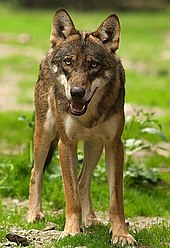
The fauna of Italy includes 4,777 endemic animal species,[198] which include the Sardinian long-eared bat, Sardinian red deer, spectacled salamander, brown cave salamander, Italian newt, Italian frog, Apennine yellow-bellied toad, Italian wall lizard, Aeolian wall lizard, Sicilian wall lizard, Italian Aesculapian snake, and Sicilian pond turtle. In Italy, there are 119 mammals species,[199] 550 bird species,[200] 69 reptile species,[201] 39 amphibian species,[202] 623 fish species,[203] and 56,213 invertebrate species, of which 37,303 are insect species.[204]
The flora of Italy was traditionally estimated to comprise about 5,500 vascular plant species.[205] However, as of 2005[update], 6,759 species are recorded in the Data bank of Italian vascular flora.[206] Italy has 1,371 endemic plant species and subspecies,[207] which include Sicilian fir, Barbaricina columbine, Sea marigold, Lavender cotton, and Ucriana violet. Italy is a signatory to the Berne Convention on the Conservation of European Wildlife and Natural Habitats and the Habitats Directive, both affording protection to Italian fauna and flora.
Italy has many botanical and historic gardens, some of which are known outside the country.[208][209] The Italian garden is stylistically based on symmetry, axial geometry, and the principle of imposing order on nature. It influenced the history of gardening, especially French and English gardens.[210] The Italian garden was influenced by Roman and Italian Renaissance gardens.
The Italian wolf is the national animal of Italy,[211][212] while the national tree is the strawberry tree.[213] The reasons for these choices are related to the fact that the Italian wolf, which inhabits the Apennine Mountains and the Western Alps, features prominently in Latin and Italian cultures, such as the legend of the founding of Rome,[214] while the green leaves, white flowers and red berries of the strawberry tree, which is native to the Mediterranean region, recall the colours of the flag of Italy.[213]
Environmental problems
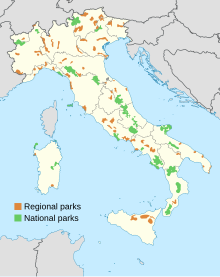
After its quick industrial growth, Italy took a long time to address its environmental problems. Many watercourses and stretches of coast have been contaminated by industrial and agricultural activity, while, because of rising water levels, Venice has experienced regular, intermittent flooding in recent years. Waste from industrial activity is not always disposed by legal means and has led to permanent adverse health effects on inhabitants of affected areas, as in the case of the Seveso disaster.
Deforestation, illegal building, and poor land-management policies have led to significant erosion all over Italy's mountainous regions, leading to major ecological disasters such as the 1963 Vajont Dam flood, and the 1998 Sarno[215] and 2009 Messina mudslides. The country had a 2019 Forest Landscape Integrity Index mean score of 3.65/10, ranking it 142nd globally out of 172 countries.[216]
Air pollution remains a severe problem, especially in the industrialised north, in the 1990s having the tenth highest level of industrial carbon dioxide emissions worldwide. Overall, Italy is the twelfth-largest carbon dioxide producer.[217][218] Extensive traffic and congestion in the largest metropolitan areas continue to cause severe environmental and health issues, even if smog levels have decreased dramatically since the 1970s and 1980s, with the presence of smog becoming an increasingly rare phenomenon and levels of sulphur dioxide decreasing.[219]

The country operated several nuclear reactors between 1963 and 1990 but, after the Chernobyl disaster and a referendum on the issue, the nuclear programme was terminated, a decision that was overturned by the government in 2008, with plans to build up to four nuclear power plants with French technology. This was in turn struck down by a referendum following the Fukushima nuclear accident.[220]
In the last decade, Italy has been one of the world's leading producers of renewable energy, in 2010 ranking as the world's fourth largest provider of installed solar energy capacity[221][222] and the sixth largest provider of wind power capacity.[223] Renewable energy provided approximately 37% Italy's energy consumption in 2020.[224] After several improvements, Italy now ranks 84th in the world for ecological sustainability.[225] National parks cover about 5% of the country,[226] while the total area protected by national parks, regional parks, and nature reserves covers about 10.5% of the Italian territory,[227] and 12% of Italy's coastline is protected.[228]
Politics
Italy has been a unitary parliamentary republic since 2 June 1946, when the monarchy was abolished by a constitutional referendum. The President of Italy (Presidente della Repubblica), Sergio Mattarella since 2015, is Italy's head of state. The president is elected for a single seven-year term by the Italian Parliament and some regional voters in joint session. Italy has a written democratic constitution that resulted from a Constituent Assembly formed by the representatives of all the anti-fascist forces that contributed to the defeat of Nazi and Fascist forces during the liberation of Italy during World War II and the Italian civil war.[229]
Government
Italy has a parliamentary government based on a mixed proportional and majoritarian voting system. The parliament is perfectly bicameral, each house with the same powers. The two houses: the Chamber of Deputies meets in Palazzo Montecitorio, and the Senate of the Republic meets in Palazzo Madama. A peculiarity of the Italian Parliament is the representation given to Italian citizens permanently living abroad: 8 Deputies and 4 Senators are elected in four distinct overseas constituencies. In addition, the Italian Senate is also characterised by a small number of senators for life, appointed by the president "for outstanding patriotic merits in the social, scientific, artistic or literary field". Former presidents are ex officio life senators.
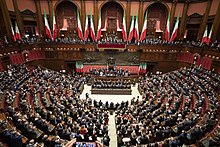
The prime minister, officially the President of the Council of Ministers (Presidente del Consiglio dei Ministri), is Italy's head of government and has executive authority but must receive a vote of approval from the Council of Ministers to execute most policies. The prime minister and the cabinet are appointed by the President of the Republic of Italy and confirmed by a vote of confidence in parliament. To remain as the prime minister, one also has to pass subsequent votes of confidence or no confidence. The role of the Italian prime minister is similar to that of most other parliamentary systems; but in Italy, the prime minister is not authorised to request the dissolution of parliament. Another difference from similar offices in other countries is that in Italy the overall political responsibility for intelligence is with the prime minister. By virtue of that, the prime minister has exclusive power to coordinate intelligence policies, determine the financial resources, and strengthen national cyber security; apply and protect State secrets; and to authorise agents to carry out operations, in Italy or abroad.[230]
Italy's three major political parties are the Brothers of Italy, the Democratic Party, and the Five Star Movement. During the 2022 general election, these three parties and their coalitions won 357 out of the 400 seats available in the Chamber of Deputies, and 187 out of 200 in the Senate. The centre-right coalition which included: Giorgia Meloni's Brothers of Italy, Matteo Salvini's League, Silvio Berlusconi's Forza Italia, and Maurizio Lupi's Us Moderates, won a majority of the seats in parliament. The rest of the seats were taken by the centre-left coalition which included: Enrico Letta's Democratic Party, Angelo Bonelli's Greens and Left Alliance, Aosta Valley, Emma Bonino's More Europe, and Luigi Di Maio's Civic Commitment, as well as Giuseppe Conte's Five Star Movement, Carlo Calenda's Action – Italia Viva, Philipp Achammer and Philipp Achammer's South Tyrolean People's Party, Cateno De Luca's South Calls North, and Ricardo Antonio Merlo's Associative Movement of Italians Abroad.
Law and criminal justice

The law of Italy has several sources. These are hierarchical: the law or regulation from a lower source cannot conflict with the rule of an upper source (hierarchy of sources).[231] The Constitution of 1948 is the highest source.[232] The Constitutional Court of Italy (Corte Costituzionale) rules on the conformity of laws with the constitution and is a post–World War II innovation. The judiciary of Italy also bases their decisions on Roman law modified by the Napoleonic Code and later statutes. The Supreme Court of Cassation is the highest court in Italy for both criminal and civil appeals.
Italy is regarded as lagging behind other Western European nations in terms of LGBT rights.[233] Additionally, Italy's law prohibiting torture is considered behind international standards.[234]
The Italian law enforcement system is complex with multiple police forces.[235] The national policing agencies are the Polizia di Stato (State Police), the Arma dei Carabinieri, the Guardia di Finanza (Financial Guard), and the Polizia Penitenziaria (Prison Police),[236] as well as the Guardia Costiera (Coast Guard Police).[235] Although policing in Italy is primarily provided on a national basis,[236] there also exists the Polizia Provinciale (Provincial Police) and the Polizia Municipale (Municipal Police).[235]
Since their appearance in the middle of the 19th century, Italian organised crime and criminal organisations have infiltrated the social and economic life of many regions in Southern Italy; the most notorious of which being the Sicilian Mafia, which would later expand into some foreign countries including the United States. Mafia receipts may reach 9%[237][238] of Italy's GDP.[239] A 2009 report identified 610 comuni which have a strong Mafia presence, where 13 million Italians live and 14.6% of the Italian GDP is produced.[240][241] The Calabrian 'Ndrangheta, nowadays probably the most powerful crime syndicate of Italy, accounts alone for 3% of the country's GDP.[242]
However, at 0.013 per 1,000 people, Italy has only the 47th highest murder rate,[243] compared to 61 countries, and the 43rd highest number of rapes per 1,000 people, compared to 64 countries in the world. These are relatively low figures among developed countries.
Foreign relations

Italy is a founding member of the European Economic Community (EEC), now the European Union (EU), and of NATO. Italy was admitted to the United Nations in 1955, and it is a member and a strong supporter of a wide number of international organisations, such as the Organisation for Economic Co-operation and Development (OECD), the General Agreement on Tariffs and Trade/World Trade Organization (GATT/WTO), the Organization for Security and Co-operation in Europe (OSCE), the Council of Europe, and the Central European Initiative. Its recent turns in the rotating presidencies of international organisations include those of the Organization for Security and Co-operation in Europe in 2018, the G7 in 2017, and the EU Council from July to December 2014. Italy is also a recurrent non-permanent member of the UN Security Council, the most recently in 2017.
Italy strongly supports multilateral international politics, endorsing the United Nations and its international security activities. In 2013, Italy had 5,296 troops deployed abroad, engaged in 33 UN and NATO missions in 25 countries of the world.[244] Italy deployed troops in support of UN peacekeeping missions in Somalia, Mozambique, and East Timor. Italy also provides support for NATO and UN operations in Bosnia, Kosovo, and Albania, and deployed over 2,000 troops to Afghanistan in support of Operation Enduring Freedom (OEF) from February 2003.
Italy supported international efforts to reconstruct and stabilise Iraq, but it had withdrawn its military contingent of some 3,200 troops by 2006, maintaining only humanitarian operators and other civilian personnel. In August 2006, Italy deployed about 2,450 troops in Lebanon for the United Nations' peacekeeping mission UNIFIL.[245] Italy is one of the largest financiers of the Palestinian National Authority, contributing €60 million in 2013 alone.[246]
Military

The Italian Army, Navy, Air Force, and Carabinieri collectively form the Italian Armed Forces, under the command of the High Council of Defence, presided over by the President of Italy, as per article 87 of the Constitution of Italy. According to article 78, the Parliament has the authority to declare a state of war and vest the necessary war-making powers in the government.
Despite not being a branch of the armed forces, the Guardia di Finanza ("Financial Guard") has military status and is organized along military lines.[e] Since 2005, military service has been voluntary.[247] In 2010, the Italian military had 293,202 personnel on active duty,[248] of which 114,778 are Carabinieri.[249] As part of NATO's nuclear sharing strategy, Italy also hosts 90 United States B61 nuclear bombs located at the Ghedi and Aviano air bases.[250]
The Italian Army is the national ground defence force. It was formed in 1946, after World War II, when Italy became a republic following a referendum, from what remained of the Regio Esercito (the "Royal Army", which was established on the occasion of the proclamation of the Kingdom of Italy in 1861). Its best-known combat vehicles are the Dardo infantry fighting vehicle, the Centauro tank destroyer, and the Ariete tank, and among its aircraft are the Mangusta attack helicopter, deployed on EU, NATO, and UN missions. It also has at its disposal many Leopard 1 and M113 armoured vehicles.
The Italian Navy is a blue-water navy. It was formed in 1946, after World War II, when Italy became a republic, from what remained of the Regia Marina (the "Royal Navy", which was established on the occasion of the 1861 proclamation of the Kingdom of Italy). In modern times the Italian Navy, being a member of the EU and NATO, has taken part in many coalition peacekeeping operations around the world. In 2014, the Navy operated 154 vessels in service, including minor auxiliary vessels.[251]
The Italian Air Force was founded as an independent service arm on 28 March 1923 by King Victor Emmanuel III as the Regia Aeronautica ("Royal Air Force"). After World War II, when Italy became a republic, it was renamed as the Regia Aeronautica. In 2021, the Italian Air Force operated 219 combat jets. A transport capability is guaranteed by a fleet of 27 C-130Js and C-27J Spartan. The acrobatic display team is the Frecce Tricolori ("Tricolour Arrows").
An autonomous corps of the military, the Carabinieri are the gendarmerie and military police of Italy, policing the military and civilian population alongside Italy's other police forces. While the different branches of the Carabinieri report to separate ministries according to their individual functions, the corps reports to the Ministry of Internal Affairs when maintaining public order and security.[252]
Administrative divisions
Italy is constituted of 20 regions (regioni)—five of which have special autonomous status which enables them to enact legislation on additional matters.[253]
The regioni contain 107 provinces (province) or metropolitan cities (città metropolitane), and 7,904 municipalities (comuni).[253]
Demographics
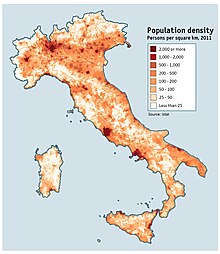
At the beginning of 2020, Italy had 60,317,116 inhabitants.[254] The resulting population density, of 202 inhabitants per square kilometre (520/sq mi), is higher than that of most Western European countries. However, the distribution of the population is widely uneven. The most densely populated areas are the Po Valley (which accounts for almost a half of the national population) and the metropolitan areas of Rome and Naples, while vast regions such as the Alps and Apennine highlands, the plateaus of Basilicata, and the island of Sardinia, as well as much of Sicily, are sparsely populated.
The population of Italy almost doubled during the 20th century, but the pattern of growth was extremely uneven because of large-scale internal migration from the rural South to the industrial cities of the North, a consequence of the Italian economic miracle of the 1950–1960s. High fertility and birth rates persisted until the 1970s, after which they started to decline. The population rapidly aged; by 2010, one in five Italians was over 65 years old, and the country currently has the fifth oldest population in the world, with a median age of 46.5 years.[255][256] However, in recent years Italy has experienced significant growth in birth rates.[257] The total fertility rate has also climbed from an all-time low of 1.18 children per woman in 1995 to 1.41 in 2008,[258] albeit still below the replacement rate of 2.1 and considerably below the high of 5.06 children born per woman in 1883.[259] Nevertheless, the total fertility rate is expected to reach 1.6–1.8 in 2030.[260]
From the late 19th century to the 1960s, Italy was a country of mass emigration. Between 1898 and 1914, the peak years of Italian diaspora, approximately 750,000 Italians emigrated each year.[261] The diaspora included more than 25 million Italians and it is considered the greatest mass migration of recent times.[262] As a result, today more than 4.1 million Italian citizens live abroad,[263] while at least 60 million people of full or part Italian ancestry live outside of Italy, most notably in Argentina,[264] Brazil,[265] Uruguay,[266] Venezuela,[267] the United States,[268] Canada,[269] Australia,[270] and France.[271]




